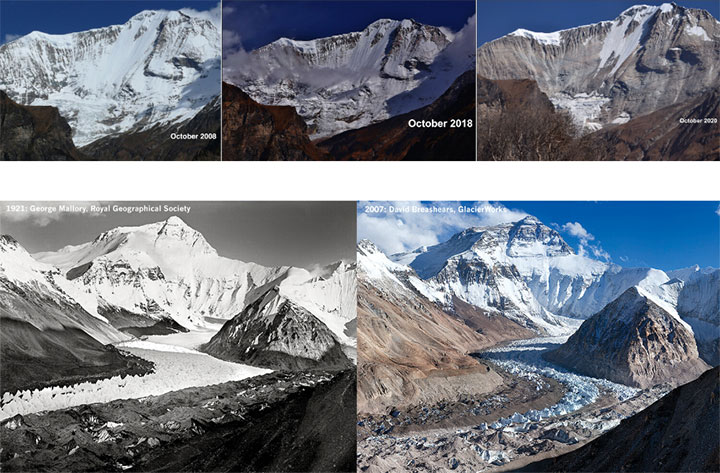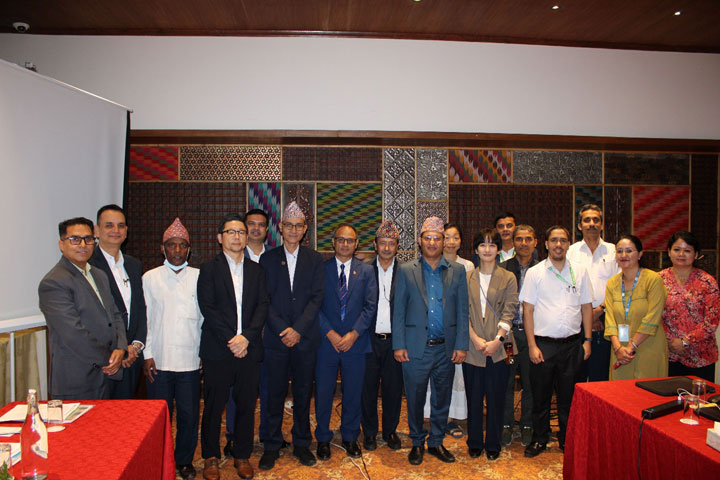The project has now entered the implementation phase following the completion of the detailed planning phase
Nepal, a mountainous country located in the Himalayas, has an area about 1.8 times the size of Hokkaido. It is home to a wide range of landscapes, from high mountain regions including the 8,000m peaks of the Himalayas, to mid-mountain and hilly areas, and even flat plains at around 60 meters above sea level that border India. Within these diverse landscapes, people of various languages and cultures live together.
Please compare the photos of the Himalayas below. These images show the impact of global warming, as they illustrate the melting glaciers in the Himalayas.
Nepal is said to be more vulnerable to the impacts of climate change than other regions due to its topography. In addition to glacier melt, in recent years, Nepal has also been experiencing frequent incidents of wildfires, landslides, and floods. On the other hand, Nepal lacks the economic and technical capacity to adapt to these climate changes, which makes it one of the countries most severely affected by climate change. Therefore, implementing adaptation strategies, which are one of the key components of climate change response, has become an urgent priority.

(Reference:Nepali Times(https://nepalitimes.com/banner/copout-at-cop26))
The project “Project for Climate Change Adaptation through Sustainable Forest Management in Nepal” was started in October 2022 in Nepal, a country heavily impacted by climate change. This project is partnering with the Federal Ministry of Forests and Environment, which is responsible for climate change measures, and the Ministry of Industry, Tourism, Forests, and Environment of Gandaki Province, which was selected as a target province by the federal ministry during the development of the basic plan. It is a technical cooperation project aimed at strengthening their organizational capacity to promote the dissemination of adaptation measures using natural resources, such as forests. This project will be implemented over five years, until 2027.
We had been working on the “detailed planning phase” to finalize the specifics of the project activities for approximately one year since the project began. Normally, the “detailed planning phase” is carried out during the formulation stage before the project starts, and then the project is implemented. However, there were various constraints, such as the COVID-19 pandemic, which caused restrictions on travel to the field and the inability to hold face-to-face meetings with the counterparts. Therefore, a “basic plan”, which outline the general design of the project, was developed before the project started, and the “detailed planning phase” was carried out after the project began.

Photo: the 2nd meeting of the Joint Coordinating Committee (JCC)
The detailed project activity plan in collaboration with the counterpart officials and community members was developed, after holding meetings with government officials, conducting interviews with NGOs and other donor organizations, visiting field sites where forest and watershed management activities are being implemented, holding consultations with communities, and conducting various surveys and analyses. The final plan was approved at the meeting of the Joint Coordinating Committee (JCC), the highest decision-making body of the project, held in September 2023, and the project has now moved into the implementation phase.
The followings are the specific activities that will be implemented in the project moving forward. This project has two main components. The first component focuses on activities at the federal level to promote the implementation of adaptation policies. The second component, on the other hand, focuses on activities at the provincial and field levels to implement adaptation practices. Each component has specific outcomes related to capacity building. The outline of the planned activities, which will be carried out together with each counterpart, is as follows:
Component 1
Output 1.1: Develop and revise policy tools such as guidelines and manuals to promote climate change adaptation through sustainable forest management.
In order to promote the implementation of climate change adaptation and forest/watershed management policies and basic plans already developed in Nepal at the federal level, existing tools such as guidelines will be revised and updated, based on consultations with relevant agencies. The revised tools will be tested in the field, and the monitoring and evaluation results will be fed back into the tools to make them more practical and effective. The aim is to promote the use of these tools among local governments.
Output 1.2: Develop and update training modules and other resources to accelerate the implementation of adaptation policies through forest and watershed management.
Training programs aimed at promoting the implementation of adaptation measures in collaboration with the training section of the Forest Research and Training Center, which is part of the Federal Ministry of Forests and Environment and responsible for capacity building through training for forest officers, will be planed, organized and evaluated. The goal is to develop effective training modules or update existing ones. To achieve this output, it is also planned to strengthen the organizational capacity of the training section at the Forest Research and Training Center.
Component 2
Output 2.1: Extract good practices and lessons learned to promote climate change adaptation through sustainable forest management at the provincial level through filed activities in Gandaki Province.
During the detailed planning phase, the criteria and procedures for selecting sites for field demonstration activities on climate change adaptation using forest ecosystems were discussed with the counterpart, the Gandaki Province Ministry of Industry, Tourism, Forests, and Environments. Subsequently, three districts —Parbat, Tanahun, and Syangya —located in highly vulnerable sub-watershed were identified. Within each district, micro-watersheds with particularly high vulnerability were selected to be the target sites for the demonstration activities (hereinafter referred to as “demo activities”). Furthermore, from these target sites, one community forestry user group per site, for a total of three groups, was selected based on criteria such as the potential for implementing demo activities, accessibility, and considerations of gender equality and social inclusion. In these target communities, supports from the project for the development of activity plan in the areas of participatory forest management, soil improvement, watershed conservation, and livelihood enhancement (including agroforestry) were provided. The demo activities selected by the community forestry user groups are as follows.
| Community (District) | Demonstration Activities | |
| Area | Activity | |
| Eksale Community Forestry User Group (Parbat District) | Forest Management |
|
| Soil Improvement and Watershed Conservation |
|
|
| Livelihood Enhancement (including Agroforestry) |
|
|
| Paharepani Community Forestry User Group (Tanahun District) | Forest Management |
|
| Soil Improvement and Watershed Conservation |
|
|
| Livelihood Enhancement (including Agroforestry) |
|
|
| Tamtaretro Community Forestry User Group (Syangja District) | Forest Management |
|
| Soil Improvement and Watershed Conservation |
|
|
| Livelihood Enhancement (including agroforestry) |
|
|
The implementation of activities by the community forestry user groups based on this demonstration activity plan will be supported by the project, and monitoring and evaluation of the activities in order to compile good practices and lessons learned will be conducted.
Output 2.2: Strengthen the capacity of Gandaki Province Ministry of Industry, Tourism, Forest, and Environment officials and local communities to implement field demonstration activities related to Output 2.1.
During the detailed planning phase, a capacity assessment was conducted for provincial government officials prior to the implementation of various technical trainings on climate change adaptation using forest ecosystems. Based on the results of this assessment, a training plan for provincial government officials will be developed, and on-the-job training will be provided to relevant government officials participating in the filed demonstration activities. Additionally, practical training plans will be developed for community residents (particularly women, lower caste groups, indigenous people, and poor households). These training sessions will focus on climate change adaptation and livelihood improvement measures using forest ecosystems, with training and subsequent monitoring and evaluation conducted for the targeted community residents in the selected areas.
In Component 2, the ultimate goal is to develop a climate change adaptation dissemination model based on the knowledge and lessons learned from the implementation of demonstration activities under Output 2.1 and training for government officials and local communities under output 2.2. At this point, it is envisioned that the climate change adaptation dissemination model will be a packaged set of activities and approaches aimed at strengthening the climate change adaptation capacity of the community as a whole. Furthermore, the model including not only the adaptation activities but also capacity building for key stakeholders involved in the dissemination of adaptation measures, such as the District Forest Office and Soil and Watershed Management Office of the Gandaki Province Ministry of Industry, Tourism, Forest, and Environment will be considered. It will also encompass activities to support communities provided by these government agencies.
